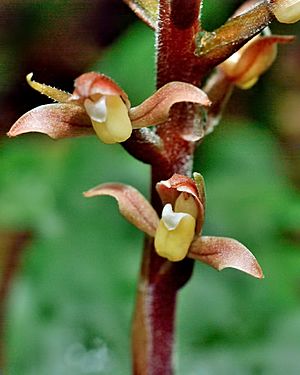Giant jewel orchid facts for kids
Quick facts for kids Giant jewel orchid |
|
|---|---|
 |
|
| Goodyera rubicunda | |
| Scientific classification | |
| Genus: |
Goodyera
|
| Species: |
rubicunda
|
| Synonyms | |
|
List of synonyms
Neottia rubicunda Blume
Georchis rubicunda (Blume) Rchb.f. Orchiodes rubicundum (Blume) Kuntze Epipactis rubicunda (Blume) A.A.Eaton Neottia grandis Blume Spiranthes grandis (Blume) Hassk. Goodyera celebica Blume Goodyera grandis (Blume) Blume Goodyera rubens Blume Goodyera papuana Ridl. Orchiodes celebicum (Blume) Kuntze Orchiodes grande (Blume) Kuntze Goodyera ochroleuca F.M.Bailey Goodyera triandra Schltr. Epipactis grandis A.A.Eaton Epipactis papuana (Ridl.) A.A.Eaton Epipactis triandra (Schltr.) A.A.Eaton Goodyera anomala Schltr. Goodyera rubicunda var. celebica (Blume) Schltr. Goodyera longibracteata Hayata Goodyera confundens J.J.Sm. Goodyera longicolumna Hayata Goodyera rubicunda var. amboinensis J.J.Sm. Goodyera hispidula R.S.Rogers & C.T.White Peramium longibracteatum (Hayata) Makino Peramium longicolumnum (Hayata) Makino Goodyera yaeyamae Ohwi Goodyera rubicunda var. triandra (Schltr.) N.Hallé Goodyera clavata N.Pearce & P.J.Cribb Salacistis ochroleuca (F.M.Bailey) M.A.Clem. & D.L.Jones Goodyera rubicunda var. australis Juswara |
|
The Giant jewel orchid, also known as Goodyera rubicunda, is a beautiful type of orchid flower. It grows naturally in warm, damp places like India, parts of Asia, Southeast Asia, New Guinea, Queensland in Australia, and some Pacific Islands. You can often find it in wet forests and rainforests. This orchid has large, egg-shaped leaves, usually between three and six of them. Its flowers are a mix of dull pink and white, and they feel a bit hairy on the outside.
What the Giant Jewel Orchid Looks Like
The Goodyera rubicunda is a perennial herb. This means it's a plant that lives for more than two years and doesn't have a woody stem. It grows from a tuber, which is a swollen underground stem that stores food.
This orchid usually has three to six dark green leaves. Sometimes, these leaves might have a reddish tint. Each leaf is about 60–120 mm (2–5 in) long and 30–50 mm (1–2 in) wide.
The flowers grow on a stem that can be 200–350 mm (8–10 in) tall. There are usually ten to twenty flowers on each stem. The flowers are a dull pink and white color and are about 6–8 mm (0.2–0.3 in) long and 7–10 mm (0.3–0.4 in) wide. They are resupinate, which means they are twisted upside down.
Each flower has different parts:
- The dorsal sepal (the top part) is about 8–10 mm (0.31–0.39 in) long and 3 mm (0.1 in) wide. It forms a hood over the column, which is the central part of the orchid flower.
- The lateral sepals (the side parts) are also about 8–10 mm (0.31–0.39 in) long and 4 mm (0.2 in) wide. They are curved and spread out.
- The petals are about 7–8 mm (0.28–0.31 in) long and 3 mm (0.1 in) wide. They are almost see-through.
- The labellum is a special lip-like petal, usually white or cream-colored. It's about 7–9 mm (0.28–0.35 in) long and 6–7 mm (0.2–0.3 in) wide. It has hairs on the inside that point inwards.
In Australia, these orchids typically bloom from September to October.
How the Orchid Got its Name
The giant jewel orchid was first officially described in 1825 by a scientist named Carl Ludwig Blume. He gave it the name Neottia rubicunda. Later, in 1839, another scientist named John Lindley changed its name to Goodyera rubicunda.
The second part of its name, rubicunda, comes from a Latin word. It means "reddish," "ruddy," or "red." This probably refers to the reddish tint that the leaves can sometimes have.
Where the Giant Jewel Orchid Lives
The Goodyera rubicunda orchid likes to grow in damp and wet areas within forests. You can find it in many places around the world, including:
- China
- North-eastern India
- Indonesia
- Japan (including the Ryukyu Islands)
- Malaysia
- New Guinea
- The Philippines
- Vietnam
- Queensland, Australia
- Various Pacific islands

